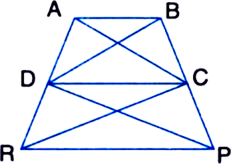 Long Answer Type
Long Answer Type
 Short Answer Type
Short Answer TypeIn figure, ABCDE is a pentagon. A line through B parallel to AC meets DC produced at F. Show that
(i) ar(ΔACB) = ar(ΔACF)
(ii) ar(□AEDF) = ar(ABCDE). 

Given: AP || BQ || CR.
To Prove: ar(ΔAQC) = ar(ΔPBR).
Proof: #8757; ΔABAQ and ΔBPQ are on the same base BQ and between the same parallels BQ and AP. ∴ ar(ΔBAQ) = ar(ΔBPQ) ...(1)
V Two triangles on the same base (or equal bases) and between the
same parallels are equal in area ∵ ΔBCQ and ΔBQR are on the same base BQ and between the same parallels BQ and CR.
∴ ar(ΔBCQ) = ar(ΔBQR) ...(2)
V Two triangles on the same base (or equal bases) and between the
same parallels are equal in area Adding the corresponding sides of (1) and (2), we get
ar(ΔBAQ) + ar(ΔBCQ)
= ar(ΔBPQ) + ar(ΔBQR)
⇒ ar(ΔAQC) = ar(ΔPBR).

Show that the area of a rhombus is half the product of the lengths of its diagonals.
Or
Prove that the area of a rhombus is equal to half the rectangle contained by its diagonals.
